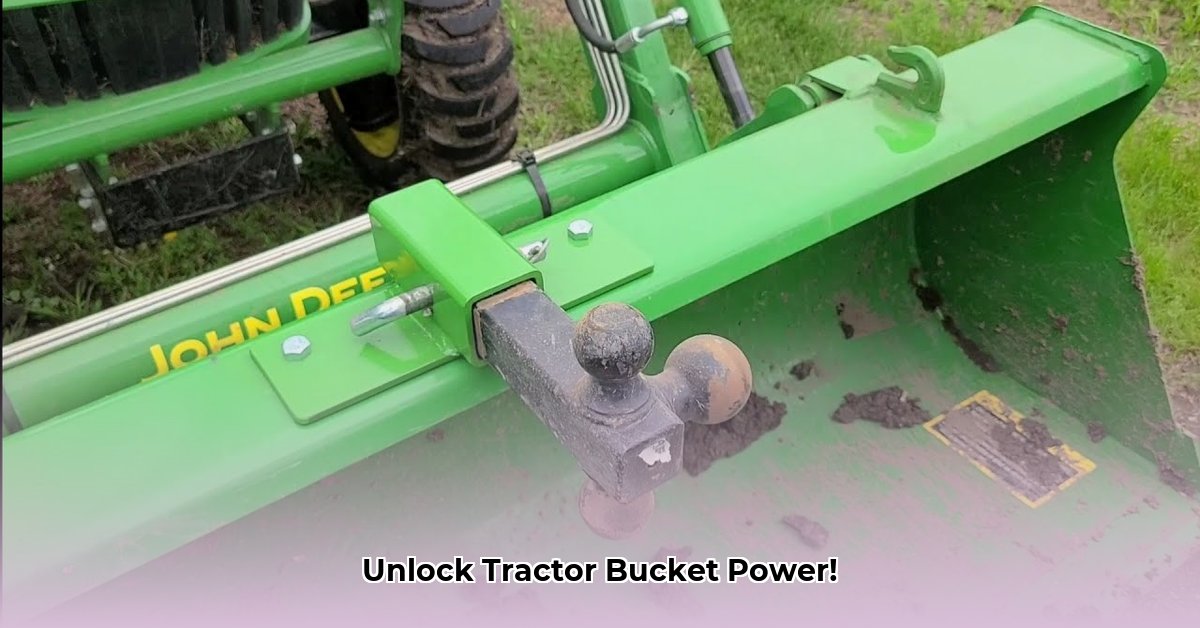
Want to enhance your tractor bucket's efficiency and potentially contribute to more sustainable farming practices? A ball hitch can significantly improve your operations. This guide provides a step-by-step approach to selecting, installing, maintaining, and safely using a ball hitch for your tractor bucket. While we explore potential benefits for sustainability, such as reduced fuel consumption, we acknowledge that conclusive research supporting these claims is currently limited. This guide prioritizes practical application and safe operation. For more on tractor bucket attachments, see this helpful resource: additional resources.
Choosing the Right Ball Hitch: A Critical First Step
Selecting the appropriate ball hitch is paramount for both safety and efficiency. A poorly chosen hitch risks equipment damage, reduced productivity, and potentially, accidents. Consider these factors:
Weight Capacity: Avoiding Overburdening
The hitch's weight capacity must exceed the combined weight of the bucket and its maximum load. Overloading is dangerous and leads to premature wear and equipment failure. Always consult your tractor's owner's manual for its lifting capacity to ensure you stay well within safe operating limits. Don't underestimate the weight; it's better to err on the side of caution.
Material Selection: Durability and Environmental Impact
Steel is the most common material, but its susceptibility to rust is a concern. Consider hitches with corrosion-resistant coatings or stainless steel for enhanced longevity. While stainless steel might have a higher upfront cost, its extended lifespan can offset this expense over time. Further research is needed to fully assess the long-term environmental impact of manufacturing and disposal of various hitch materials.
Compatibility: Ensuring a Seamless Fit
The ball hitch must be compatible with your tractor's three-point hitch system and your bucket's mounting points. Improper compatibility leads to instability and potential equipment damage. Carefully check your tractor and bucket manuals for precise specifications. A slight mismatch can have significant consequences.
Hitch Ball Size: Precision is Key
Hitch balls come in various sizes. A mismatch between the ball size and the receiver on your tractor's three-point hitch system is dangerous and could lead to catastrophic equipment failure. Always verify compatibility before installation.
Safety Features: Prioritizing Safe Operation
Prioritize safety features that prevent accidental detachment. These can range from simple locking pins to more advanced systems. Safety should be paramount in your decision-making process.
Installing Your Ball Hitch: A Step-by-Step Guide
Proper installation prevents accidents and ensures efficient operation. Always follow the manufacturer's instructions carefully.
Step 1: Preparation: Park your tractor on a level surface, engage the parking brake, and shut off the engine. This establishes a safe working environment.
Step 2: Connecting to the Tractor: Carefully connect the ball hitch to your tractor's three-point hitch system, ensuring a secure and snug fit. Never force any connections.
Step 3: Attaching the Bucket: Connect the bucket to the ball hitch. Ensure all connections are secure and tight. Double-check all fastenings.
Step 4: Testing the Connection: Before lifting any significant weight, gently raise and lower the bucket several times to check for smooth, stable movement. Listen for any unusual sounds or vibrations. Address any issues immediately.
Critical Safety Note: Never work under a raised bucket or tractor.
Maintaining Your Ball Hitch: Ensuring Long-Term Reliability
Regular maintenance is crucial for extending the hitch's lifespan and preventing unexpected failures.
Regular Inspections: Inspect for wear, cracks, or damage. Replace worn or damaged components immediately. This proactive approach can prevent larger problems down the line.
Lubrication: Regularly lubricate moving parts to reduce friction and wear. Use an appropriate lubricant for metal-on-metal contact.
Corrosion Protection: Clean and dry the hitch after each use to prevent corrosion. If necessary, apply a protective coating.
Safe Usage and Minimizing Environmental Impact: Best Practices
Safe operation and environmental stewardship should always guide your actions.
Weight Limits: Never exceed the weight capacity of the hitch or your tractor. Overloading increases wear and tear and raises the risk of soil compaction. How can we balance efficiency with minimizing environmental disruption?
Smooth Movements: Avoid jerky movements when operating the bucket. Smooth, controlled movements reduce stress on the equipment and soil.
Soil Compaction Awareness: Minimize soil compaction by optimizing tire pressure and minimizing passes over the same area. Sustainable farming practices often prioritize minimizing soil disturbance.
Responsible Disposal: Dispose of worn components responsibly according to local regulations. Explore recycling options whenever possible.
Troubleshooting Common Issues: Addressing Potential Problems
Even with proper maintenance, problems can arise.
| Problem | Possible Cause(s) | Solution |
|---|---|---|
| Loose Hitch | Worn components, improper installation | Tighten connections, replace worn parts, re-check installation |
| Bucket Instability | Uneven weight distribution, worn components | Redistribute weight, replace worn parts |
| Hitch Failure | Overloading, impact damage, corrosion | Inspect for damage, replace as necessary |
| Difficult Bucket Movement | Friction, lack of lubrication | Lubricate moving parts |
This guide provides general advice. Always consult your tractor and bucket manuals for specific instructions and safety precautions. While the potential benefits of ball hitches for sustainable agriculture are promising, further research is needed to definitively quantify those advantages.
Key Takeaways: Maximizing Efficiency and Sustainability
- Choosing the right ball hitch is fundamental to maximizing efficiency and minimizing potential environmental impact.
- Proper installation and maintenance are critical for safe and reliable operation.
- Safe usage practices contribute to both operational efficiency and environmental stewardship. Addressing potential issues proactively helps prevent downtime and contributes to sustainable agricultural practices.